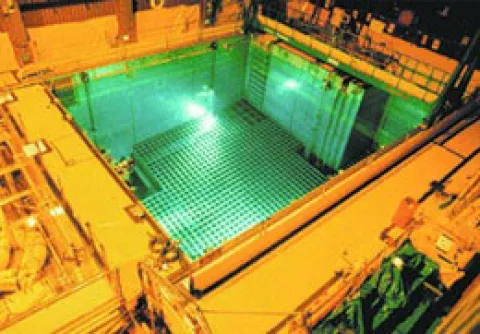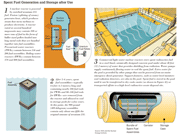Spent Fuel Pools
This webpage describes neutron absorbers in high density racks in spent fuel pools.
The water-pool option involves storing spent fuel assemblies under at least 20 feet of water, which provides adequate shielding from the radiation for anyone near the pool. The assemblies are moved into the water pools from the reactor along the bottom of water canals, so that the spent fuel is always shielded to protect workers.
About one-fourth to one-third of the total fuel load from the pools is spent and removed from the reactor every 12 to 18 months and replaced with fresh fuel.
Current regulations permit re-racking of the spent fuel pool grid and fuel assembly consolidation, subject to NRC review and approval, to increase the amount of spent fuel that can be stored in the pool. Both of these methods are constrained by the size of the pool.
On this page:
- Neutron-Absorbing Materials
- Boraflex Degradation
- Other Neutron-Absorbing Materials
- Continuing NRC Actions to Address Neutron-Absorbing Material Degradation
- Spent Fuel Pool Criticality Management Database
- Key Documents
Neutron-Absorbing Materials
When licensees re-rack to increase spent fuel storage, they generally replace the original storage racks in the spent fuel pool with high density storage racks that incorporate neutron absorber panels between the spent fuel assemblies to ensure subcriticality per NRC regulations. Solid neutron-absorbing materials integrated into high density storage racks have been developed in a variety of forms, but all fundamentally utilize Boron-10 (B-10) atoms to absorb neutrons and prevent criticality. Therefore, the neutron absorption capability of these materials is generally characterized by their B-10 areal density, which is measured in grams of B-10 per square centimeter (g/cm2). B-10 is generally present in the chemical form of boron carbide (B4C) within a metal matrix (e.g., Boral and Metamic (trademark of Metamic, LLC)) or a polymer matrix (e.g., Boraflex (trademark of BISCO), Carborundum, and Tetrabor), although borated stainless steel incorporates the B-10 atoms into the alloy composition.
Neutron-absorbing panels are generally enclosed within a panel cavity by a wrapper plate that may or may not allow interaction with the water in the spent fuel pool. Therefore, the neutron-absorbing materials may be exposed to borated or unborated water or kept dry. These materials may also be exposed to alpha, beta, gamma, and neutron radiation from the spent fuel. The solid neutron materials can degrade or deform over time in the spent fuel pool environment, potentially reducing their B-10 areal density and capability to absorb neutrons. Among the neutron-absorbing materials credited by licensees, polymer-based materials such as Boraflex, Carborundum, and Tetrabor have experienced the most significant degradation.
Boraflex Degradation
In the 1970s and 1980s, Boraflex was the first neutron-absorbing material to exhibit degradation, as documented in Information Notices (INs) 87-43, 93-70, 95-38, and 12-13 and Generic Letter (GL) 96-04. In license renewal, there is also aging management program guidance in the Generic Aging Lessons Learned (GALL) Report Revision 2: XI.M22 Boraflex Monitoring Program (NUREG – 1801). The NRC issued two technical letter reports (TLRs) in 2012: "Boraflex, RACKLIFE, and BADGER: Description and Uncertainties" (Agencywide Documents Access and Management Systems (ADAMS) Accession Number ML12216A307) and "Initial Assessment of Uncertainties Associated with BADGER Methodology" (ADAMS Accession Number ML12254A064) on the Boraflex neutron-absorbing material and various surveillance techniques.
These two TLRs discussed some of the methods that licensees use to monitor the degradation of Boraflex neutron-absorbing materials. The staff had commissioned these reports to gather more information on surveillance methodologies for neutron-absorbing materials employed in spent fuel pools. The two TLRs issued in 2012 also identify uncertainties in the methodologies employed to monitor the performance of neutron-absorbing materials. The reports provide a generic overview on the use of certain surveillance tools and an in-situ measurement technique and discuss the reliability of these methodologies for certain applications. Some licensees use these surveillance tools to demonstrate compliance with their technical specifications and NRC regulations.
Other Neutron-Absorbing Materials
For other materials, the staff issued IN 09-26 to provide current operating experience on neutron-absorbing material degradation in spent fuel pools to the industry. The staff has also issued interim staff guidance (LR-ISG 2009-01) describing attributes of an acceptable aging management program for neutron-absorbing materials. The ISG was later incorporated into GALL Revision 2 and aging management program guidance XI.M40 Monitoring of Neutron-absorbing Materials Other Than Boraflex. In addition, GL 78-11 gives guidance on what is acceptable for a neutron-absorbing material surveillance program to ensure subcriticality.
In addition, specifically for Carborundum and Tetrabor, "Monitoring Degradation of Phenolic Resin-Based Neutron Absorbers in Spent Nuclear Fuel Pools" (ADAMS Accession Number ML13141A182) discusses the characteristics of the neutron-absorbing materials Carborundum and Tetrabor, the qualification testing results, and the operating experience pertaining to degradation of these materials. The report also describes phenolic resin-based neutron-absorbing material degradation mechanisms and analyzes current surveillance methods.
Continuing NRC Actions to Address Neutron-Absorbing Material Degradation
NRC has been communicating with stakeholders since the 1980's on this neutron-absorbing material degradation issue. NRC staff has reviewed industry initiatives to monitor and manage this degradation and will continue to interface with stakeholders and licensees on the results of the ongoing studies. The staff is also considering a Generic Letter to address the issue of neutron-absorbing material degradation.
Spent Fuel Pool Criticality Management Database
The Spent Fuel Pool Criticality Management database (ML13212A064) lists the means by which each operating spent fuel pool in the entire US fleet meets its subcriticality requirement. All information in the spreadsheet is obtained from publicly available documents, but may not be entirely accurate due to the evolving nature of this information. A TLR (ML113550241) describing the information contained in the database is also available.
Key Documents
Page Last Reviewed/Updated Thursday, May 01, 2025
Page Last Reviewed/Updated Thursday, May 01, 2025



